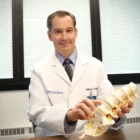Undergoing a carotid stent procedure improves blood flow to your brain and lowers your risk of having strokes. If you and your doctor decide that a carotid stent is the right option for your health, then you will want to know about the process and recovery process.
Brief Overview of the Carotid Stent Procedure
You will begin your carotid stent procedure by receiving a local anesthetic that numbs the area around your femoral artery (located at the top of your leg). You most certainly will also receive some medication to prevent pain and anxiety during the procedure.arotid stent procedure by receiving a local anesthetic that numbs the area around your femoral artery (located at the top of your leg). You most certainly will also receive some medication to prevent pain and anxiety during the procedure.
Once you’re prepared, your neurosurgeon will make a small incision in your femoral artery. Even though the stent will be placed in your carotid artery (at the front of your neck), neurosurgeons perform this minimally invasive procedure through the femoral artery. It’s safer that way and you won’t have to worry about a scar potentially developing on your neck.
Your neurosurgeon will insert a small tube called a sheath into your femoral artery. From here, he or she will thread a catheter through your body until it reaches the carotid artery. Your surgeon will use imaging technology to guide the catheter through your arteries to reach the implantation site. Since arteries don’t have nerve cells, you shouldn’t feel any discomfort during this process.
A contrast dye is injected through the catheter into your carotid artery so there is a clear view of the implantation site. You might feel a warm sensation on your face when the dye gets injected.
Now that your surgeon has a good view of your carotid artery, he or she will place an umbrella-shaped filter just after the implantation site. This filter will catch any blood clots or plaque that comes loose during your procedure. Without the filter, clots and plaque could move to the brain, where they may cause seizures and other problems.
With the protective filter in place, your neurosurgeon will inflate a small balloon to expand your carotid artery. Once the artery has been widened, the neurosurgeon will insert the stent to maintain the artery’s size. Stents are like small tubes made of metal mesh. Once implanted, they prevent the artery from collapsing, which means blood can flow to your brain properly.
Assuming that all goes well, your neurosurgeon will remove the filter, catheter and sheath to end the procedure. Now, you can begin the carotid stent recovery process.
What to Expect While You Recover in the Hospital
Most people spend 24 to 48 hours in the hospital after undergoing a carotid stent procedure. During this time, the hospital staff will monitor your vital signs to make sure you’re healthy. The staff may also perform an ultrasound test to make sure your artery is clear.
During the night, nurses will monitor your vital signs to make sure you recover well. If they don’t see any problems within 24 hours, you will probably be dismissed from the hospital. In some cases, patients will be observed for an extra day or two.
Carotid Stent Recovery at Home
Most of your carotid stent recovery will take place at home. Most people need to avoid strenuous activities for at 48 hours.
You may find that the incision site causes you some pain over the next few days. This is a normal part of the healing process. Your doctor may prescribe a pain reliever to help with the discomfort. A lot of patients, however, find that acetaminophen (Tylenol) offers the relief that they need. If the discomfort lasts more than three days, you should contact your doctor for advice.
After a day or two, you can return to your normal life. It’s smart to still avoid strenuous activities, though, for about 5 to 7 days or until the incision site is completely closed. Instead, take short walks to keep your cardiovascular system healthy. You should feel well enough to exert yourself more after a week of recovery.
We focus on outcomes
not treatments.
Let's find the most appropriate solution to your Cerebrovascular condition.
Do’s and Don’ts During Your Recovery
Follow this list of do’s and dont’s to keep yourself healthy and speed up your carotid stent recovery timeline.
Do:
- Keep the incision site clean
- Pat the incision site dry after cleaning
- Change bandages as needed
- Avoid overusing the leg where the access site was
- Take medications as your doctor instructs
- Avoid bearing down such as during a bowel movement. Stool softeners will help.
Don’t:
- Exert yourself too much
- Let the incision site stay damp
- Mix medications without talking to your doctor
- Use alcohol or tobacco products
Factors That Can Alter Your Recovery Time
Several factors can affect how long your carotid stent recovery takes.
Unclean or Wet Incision Site
Letting your incision site get wet or dirty is one of the worst things that you can do. A wet, dirty incision can become infected quickly. If you get an infection, then you will need to take antibiotics. An infection could also mean that you need to spend more time in the hospital.
Physical Exertion
Participating in physical activities may also delay the carotid stent recovery process. Exertion can cause the incision site to reopen. Many patients spend a few days with trusted loved ones so they aren’t tempted to exert themselves with common chores like cooking, cleaning and bathing.
Most people don’t have major issues during carotid stent recovery. If you experience pain, numbness or other unexplainable symptoms, contact your doctor immediately for advice.

About Neurosurgeons of NJ
Introducing our team of board certified physicians dedicated to bringing you the latest developments and treatment options. We strive to produce the most clarified & clear content to help you make informed decisions on your medical journey. The road to feeling like your true self should not feel lonely- Let us help you. Please call us to schedule a consultation and speak to one of your team members.






